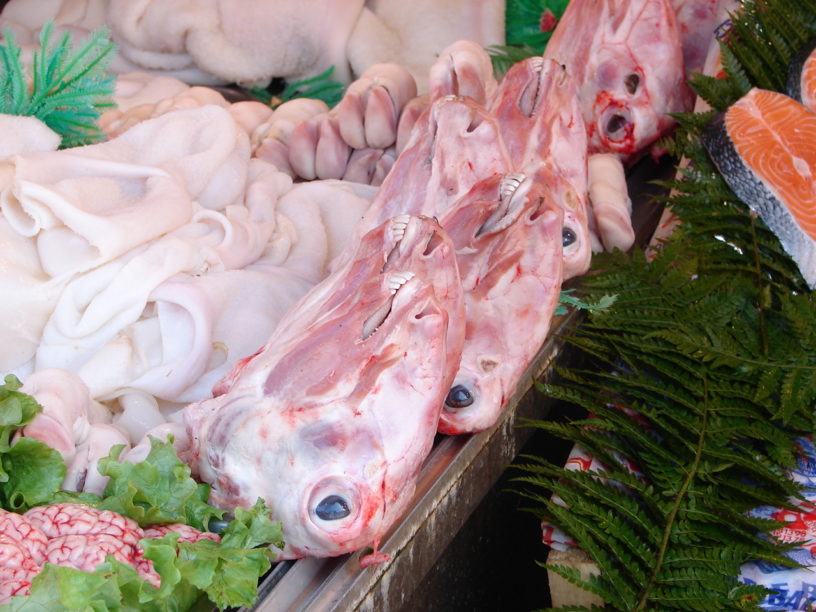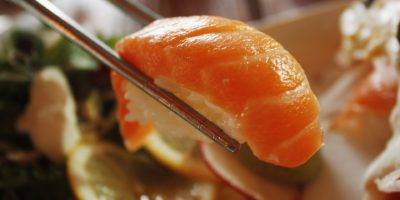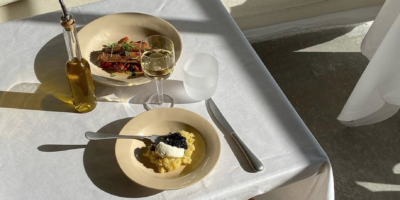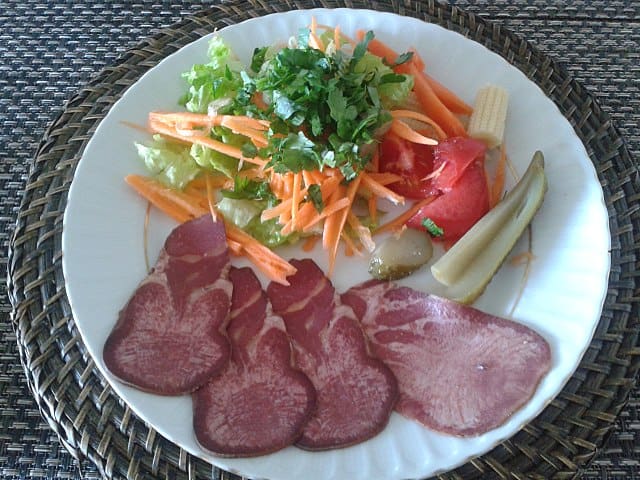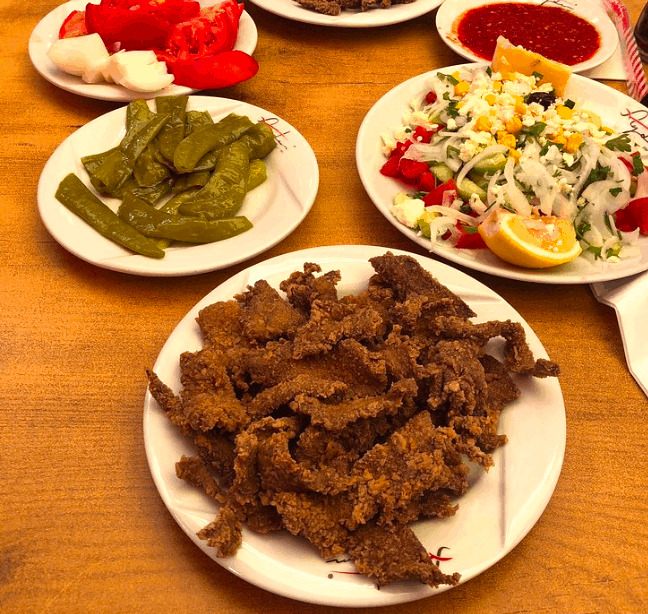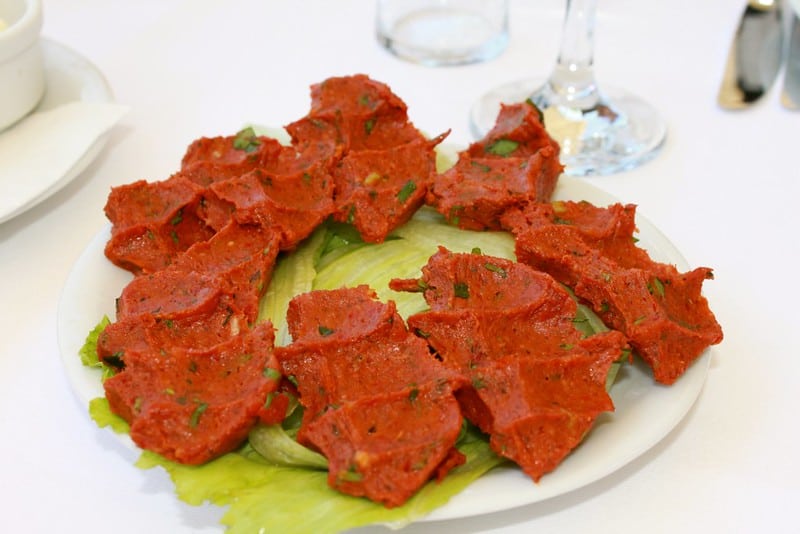Weird Food that Turkish People Eat
Every country has its fair share of amazing food and then there are some dishes that make you think twice before you even consider eating them. You’ll need a strong stomach! There is a long list of bizarre food around the world surely — Cuisses de grenouilles or Malaeng Tord — to name a few. They may seem weird to those unfamiliar with the culture or are against eating some weird parts of a sheep, lamb or cow. This article focuses on some very bizarre food from Turkey.
Some local Turkish delicacies include roasted sheep’s head, boiled sheep head or fried giblets or smoked beef tongue. How about a dessert made with chicken breast?! It tastes actually amazing and was supposedly also eaten this way by Fatih Mehmet, the Ottoman Sultan that took Constantinople and ended the Eastern Roman Empire/Byzantium. Next, there’s a long list of sour and pungent fermented drinks. Hungover? Are you ready to try some tripe and trotters soup or some roasted intestines in between a sandwich?
Some of the above actually taste great and are not as bad as they sound. Nonetheless, there are a few dishes that are hard to stomach, even for those living in the country we’d say! Let’s check them out below!
Sakatat or Offal
Translating as ‘offal’ in Turkish, Sakatat generally refers to all kinds of cow, sheep or lamb meats that are not typically used in everyday cuisine. Almost nothing goes to waste in Turkey, with regional varieties employing different preparation methods, local ingredients and spices. The meats are fried, boiled, stuffed or rolled, grilled on skewers and then wrapped in a dürüm with onions and spices such as sumac, paprika or cumin. Different cooking methods and tastes can be found, especially in the East and Southeast of the country.
Kidneys, liver, brain and lamb hearts or beef tongue can be found in the list of Sakatat. While it is enjoyed by some, most people in the country, especially in the cities, very rarely consume offal, usually only on special occasions such as Kurban Bayram or Eid al-Adha.
Şırdan or Stuffed Abomasum
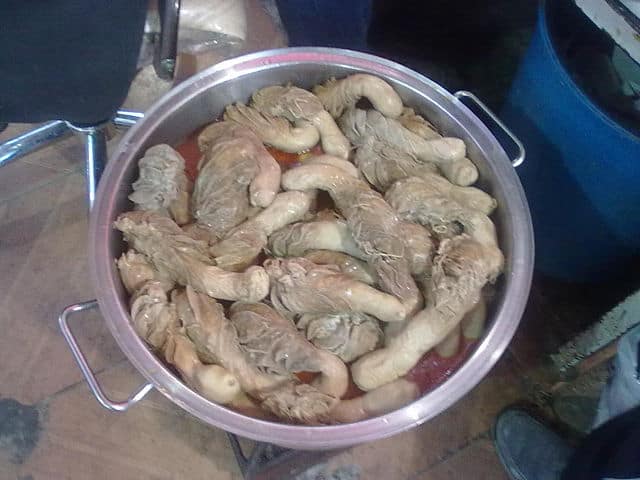
Image sourced from Flickr
If you can stomach the appearance of the food itself (that looks like the human intromittent organ!), it’s believed to be quite tasty — you be the judge, if and when you decide to try it!
Sheep abomasum and stomach is stuffed with rice, oil, spices (so it’s actually a ‘dolma’ variety) and cooked for at least 8 hours. It is then eaten by sprinkling some salt, cumin and pepper on top. It’s considered an Adana delicacy, along with Mumbar (below); so much so that it features heavily in the Tastes of Adana Festival held every year in October.
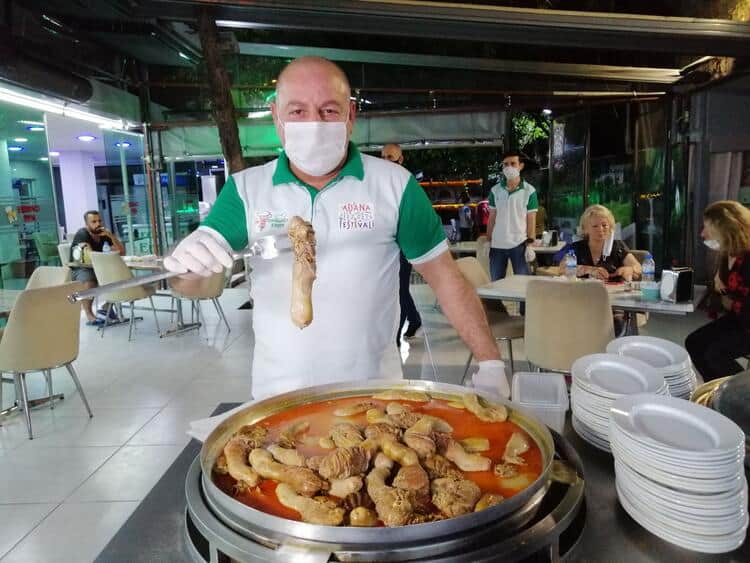
Image sourced from Hurriyet News Online
In Istanbul, you have to visit speciality restaurants that only specialize in this type of offal called “Şırdancı” (where you can also find other types of cooked offal meats). Bon appetit?!
Mumbar Dolması or Stuffed Sheep/Lamb Intestines
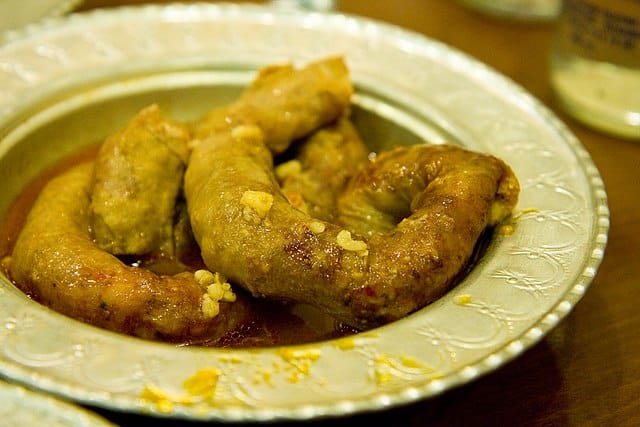
Image sourced from Wikimedia Commons
If stuffed sheep intestines or sausages with loads of spices is your thing or it piques your curiosity, you can try it in Turkey and it’s another type of dolma! The preparation involves cleaning the small intestines of sheep or lamb meticulously. They are then stuffed with bulgur or rice, ground meat, onions, tomato paste, parsley and lots of spices such as sweet purple basil, dried mint and paprika. It is usually consumed in the Southeastern provinces.
We’re not so sure about the taste as we’ve never tried it and the pictures don’t look so appetizing at all. Nonetheless, if you’re the adventurous food traveller like Food Ranger Trevor James, you can sometimes find it on the rotating menu of Çiya in Kadıköy.
Kuzu Kelle or Sheep’s Head
Roasted sheep’s head is an authentic delicacy in Turkey. The meat is extracted from the head by the shop seller/restaurant before it’s served.
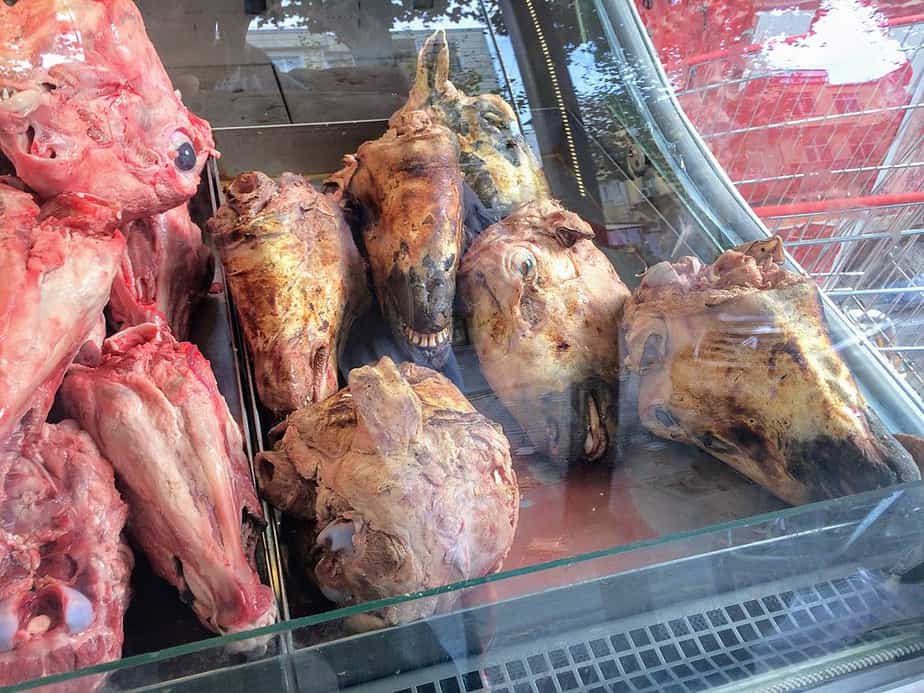
Image sourced from Wikimedia Commons
On the other hand, Kelle söğüş or boiled sheep meat is considered a delicacy in the Aegean city of Izmir. It’s enjoyed alongside pickles.
Furthermore, there are smoked meat cuts such as Füme Dil and Söğüş Dil or smoked or boiled tongue that can also be found in some speciality shops. If you’re the adventurous kind, keep an eye for displays of sheep head in most neighbourhood butcher shops. Some even roast them for you beforehand.
Ciğer or Fried Liver
Edirne in Turkish Thrace was one of the capitals of the Ottoman Empire before Constantinople. The city has some great remnants with historical monuments, mosques and a bedestan and bazaar. In terms of food culture, Edirne is known for its fried liver delicacy called ‘Edirne Ciğer’. Aydin Tava Ciğer or Meşhur Edirne Ciğercisi in the old quarters of the city is where you can try this dish!
Beef or calf liver is thinly sliced, dipped in a batter and then deep-fried until it’s crispy and perfectly crunchy. Fried dry red chilli peppers, onions and pickles are served alongside the dish.
Another dish that’s also popular in Istanbul is Albanian-style liver or Arnavut Ciğer brought to the Ottoman Empire by Albanian immigrants. Small cubes of beef or veal liver are pan-fried in oil and spices such as sumac and red pepper. Served with oven-baked potato cubes, onions and parsley, it’s an acquired taste, to be honest.
Paça Çorbalar

Image sourced from Wikimedia Commons
The word Paça generally refers to a few varieties of soups made with cow, sheep, veal, goat or lamb’s head, feet or in general, offal.
Sheep’s head (Kelle paça) soup and trotters (Ayak paça) soup are some of the most popular traditional soups in Turkey. Other varieties can be found on menus in different parts of the country such as cow or sheep tongue (Dil paça). These soups are consumed throughout the cold months, especially when the country sees tons of snow.
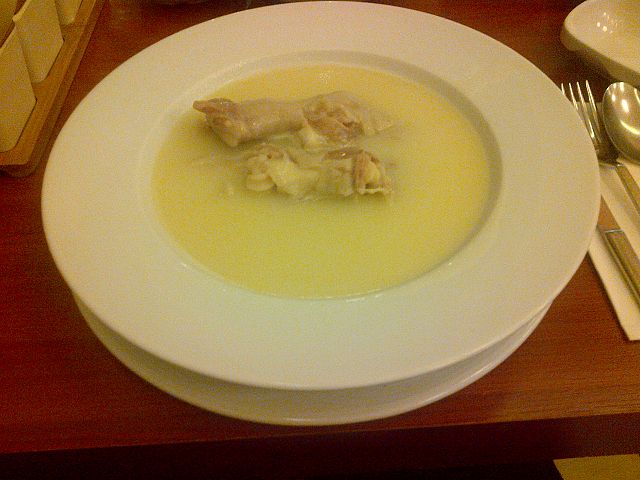
Image sourced from Wikimedia Commons
The soup is boiled for hours first with just meat until it melts off the bone. It is then thickened and flavoured with a roux of butter, flour and egg yolks. The soup can be had as is and sometimes served with the trotters swimming in the broth — good luck! If you prefer a more tangy acidic taste then vinegar and garlic are usually provided.
Try these soups, if you dare, at speciality restaurants called “Paçacı” followed by their masters’ or cooks’ names (ustalar) such as Paçacı Necip Usta or Paçacı Mahmut — some are open 24 hours a day!
Kokoreç or Roasted Intestines

Image sourced from Wikimedia Commons
This street food comprises lamb intestines wrapped around offal and is not for the faint of heart! Grilled to perfection on a horizontal rotisserie, the intestines are served inside a sandwich bread. Salt, oregano, cumin, chilli powder and tomatoes can also be requested to go with your sandwich. Different cities have their own versions offering a spicier version or ones where you can taste the meat more.
Either way, give Kokoreç a try when you’re next in Istanbul or Izmir. In Istanbul, you can find it at Şampiyon Kokoreç in Beyoğlu and Kokoretto in Kadıköy as a late-night hangover cure.
İşkembe Çorbası or Tripe Soup
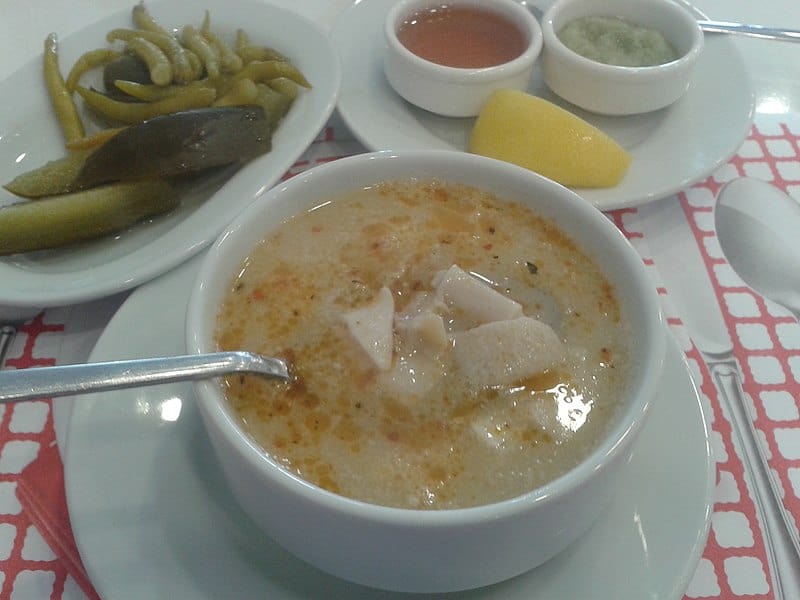
Image sourced from Wikimedia Commons
İşkembe çorbası is a traditional soup that’s made with pieces of tripe, flour and egg yolks. Served with vinegar, red pepper and garlic, the bold tangy flavour actually tastes amazing, until you realize the main component of the dish.
In Istanbul, if you ever see a restaurant advertising itself as just an ‘İşkembecisi’, then do give it a try. The shop specializes in this one dish! Otherwise, you can easily find it listed in Çorbasici shops as it’s one of the most popular soups in the country.
Tavuk Göğsü or Chicken Breast Dessert

Image sourced from Flickr
At first, finding “Tavuk Göğsü” (which translates as ‘chicken breast’) on the dessert menu can seem weird, but this Turkish milk dessert can quickly become your favourite! You can hardly taste the chicken!
A fascinating pudding (from where Kazandibi is also prepared), shredded chicken breast that’s fresh is used and added to milk, cornstarch and rice flour. The addition of the chicken adds chewiness and one can hardly taste it — certainly one of the most interesting Turkish desserts out there!
Yoghurt Soups
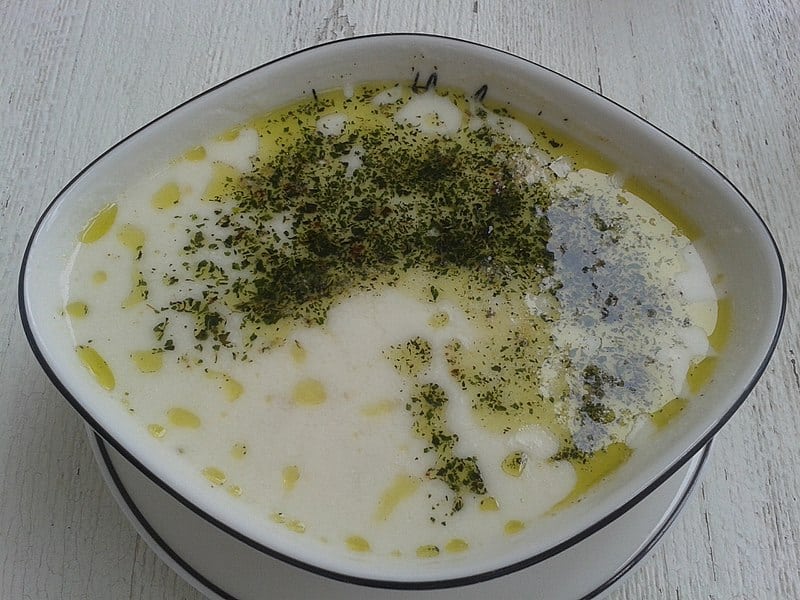
Image sourced from Wikimedia Commons
There are a variety of unusual yoghurt-based soups that may seem weird to the uninitiated. Some are served hot and others cold. Typical yoghurt soups are cooked with yoghurt, flour, herbs, egg yolk, rice and chickpeas.
This particular type of soup is called Yayla çorbası or Highland Soup. The soup is also a good choice for those suffering from colds. It’s usually served with lots of dried mint on top. Another traditional soup called Toyga çorbası is made with de-husked wheat, flour and spices, with the addition of yoghurt and boiled chickpeas.

Image sourced from Wikimedia Commons
On the other hand, Tutmaç çorbası is similar to dumplings and noodle yoghurt soups of other Turkic speaking countries. However, it differs a little in Turkey. There are no dumplings in the recipe. Instead, eriste (vermicelli or home-made noodles) and lentils are used in the Turkish version, with yoghurt and meat.
A cold version of a yoghurt soup that was popular in the old days of the Ottoman Empire exists in the country today. A more popular version called Cacık (similar to Tarator and Tzatziki) is enjoyed in the summer months depending on the thickness of the concoction (with yoghurt and cucumbers), it can be served as a side or as a mezze dish, a dip or a bowl of soup.
Soup made with the yoghurt-based drink ayran called Ayran Aşı (Ayran vaccine – a comical name with the soup having supposed medicinal properties) is served cold or hot. If you temper the dish with olive oil, mint and red pepper flakes you serve it hot, while the cold version uses dried mint, thyme and dill as a garnish on top.
Turşu Suyu or Pickle Juice

Image sourced from Flickr
Turşu (Torshi) encompasses a variety of vegetables that are pickled with either vinegar or lemon juice and fermented so they can be enjoyed later. It’s a staple in Turkish households and part and parcel of Turkish food culture. It’s enjoyed almost every day, especially with meat dishes.
The most common pickles are made from local cultivars of vegetables and fruits. Cilantro seeds, bay leaves and a good amount of vinegar are included in homemade varieties. You can find olives, gherkins, red (similar to pimentos) peppers, carrots, green pepper varieties and red/normal cabbage as pickles in Turkey.
However, it’s the unusual pickle varieties such as green beans, okra, eggplant, green almond, garlic, cauliflower, green tomatoes, onions and corn, to name a few, that are bewildering! And frankly, look inedible, perhaps not for everyone!
Pickled juice is another beverage – an acquired taste, in our humble opinion – that’s enjoyed on the streets of Turkey. Tangy and salty in taste, the drink is enjoyed alongside turşu slices and served cold. It’s available in most pickle shops or in small decorative carts on Istanbul’s seaside promenades. Alternatively, you can try it at the famous Özcan Turşuları in Kadıköy.
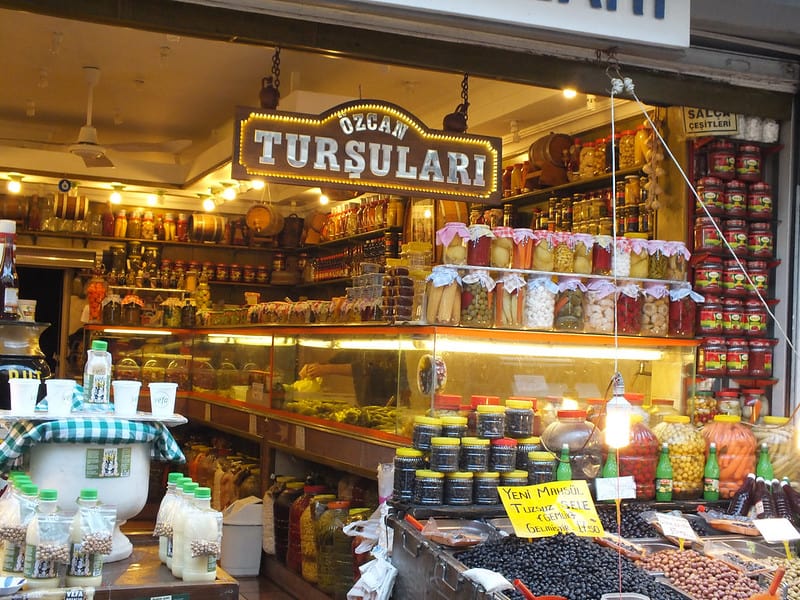
Image sourced from Flickr
Next, we have fermented fruit juice – sour, tangy and boldly acidic – these types of drinks are a thing in Turkey! For example, ‘Şalgam suyu‘ or fermented carrot juice made with red or purple pickled carrots is a rather famous variety of fermented drink (other than ayran and kefir) from the cities of Mersin and Adana. Other regional variations exist with different fruits such as grapes, called ‘Hardaliye‘, from the Trakya region.
Çiğ Köfte
Çiğ köfte is the Turkish version of steak tartar (a la Turca). It traditionally utilizes raw ground meat (lamb or beef), bulgur, onions, tomato and red pepper paste, lemon juice and spices. Parsley, mint and green onions are also added once the bulgur and onion paste is kneaded extremely well.
A spicier version of this köfte has Urfa pepper, also called ‘İsot‘, added in which has a high heat pungency.

Image sourced from Flickr
At first, it can seem a bit weird as there’s nothing quite like a raw bulgur köfte, but the taste is quite addictive balancing the spiciness and the chewiness of the bulgur with the heavy use of red pepper paste. It can quickly become your favourite snack!
Available throughout the country today, the non-meat version of çiğ köfte is enjoyed as a wrap. Greens such as iceberg lettuce, fresh parsley, fresh mint, pomegranate molasses and lemon are added. Ayran is usually consumed alongside to counter the heat and spiciness. At sit-down restaurants serving Turkish fare, it’s served as an amuse-bouche with greens and lemon slices.
Boza
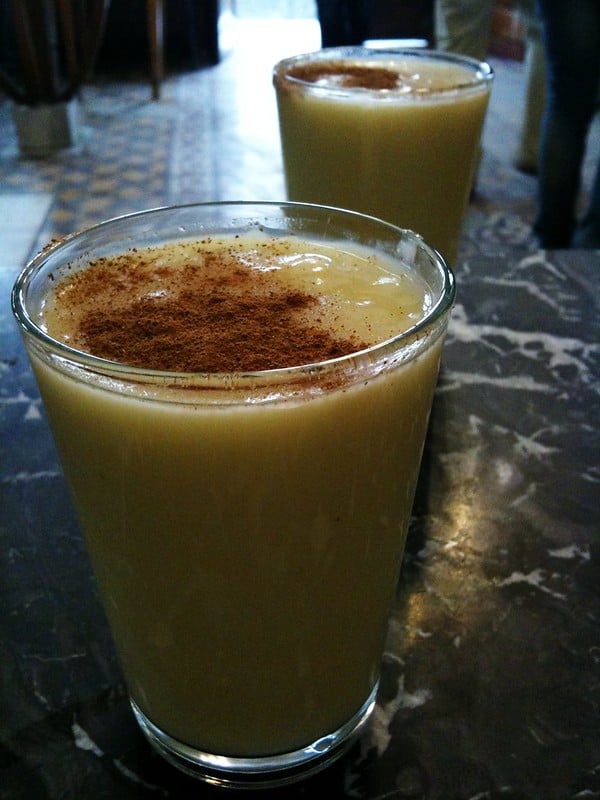
Image sourced from Flickr
A fermented drink made from grains, Boza served as a substitute for alcoholic drinks in the past due to its non-existent alcohol content. In Ottoman times, an alcoholic version of Boza existed and was even prohibited at times.
Boza is enjoyed with cinnamon powder sprinkled and even roasted chickpeas on top! It’s consumed primarily during the winter months. The drink has a soupy consistency and looks like pudding! On the other hand, the taste is pungent, sour and acidic. It’s an acquired taste to the uninitiated to be sure!

Image sourced from Flickr
Today, it can be enjoyed year-round in Istanbul. The legendary boza maker and family-business Vefa Bozacısı is quite well-known! They should be on your to-do list if you ever want to try this interesting but addictive (so they say) drink!
Planning a trip to Paris ? Get ready !
These are Amazon’s best-selling travel products that you may need for coming to Paris.
Bookstore
- The best travel book : Rick Steves – Paris 2023 – Learn more here
- Fodor’s Paris 2024 – Learn more here
Travel Gear
- Venture Pal Lightweight Backpack – Learn more here
- Samsonite Winfield 2 28″ Luggage – Learn more here
- Swig Savvy’s Stainless Steel Insulated Water Bottle – Learn more here
Check Amazon’s best-seller list for the most popular travel accessories. We sometimes read this list just to find out what new travel products people are buying.

